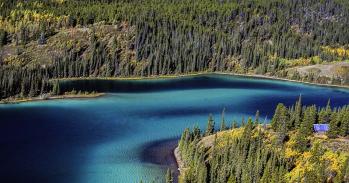
Imagine the perfect storm. A series of severe volcanic eruptions engulf the globe, spewing ash and sulphur into the atmosphere, causing widespread chaos on our intricate global economy, impacting our ability to grow food and grounding trans-continental air travel.
Imagine the perfect storm. A series of severe volcanic eruptions engulf the globe, spewing ash and sulphur into the atmosphere, causing widespread chaos on our intricate global economy, impacting our ability to grow food and grounding trans-continental air travel.
We should consider a future “Laki”-style eruption as a particular threat to Europe, and draw up plans to reduce its potential impacts.
Dr Clive Oppenheimer
This fantastic scenario is the subject of Dr Clive Oppenheimer’s lecture Eruptions that shook the world on March 13 at this year’s Cambridge Science Festival. The Festival is the UK’s biggest free science festival and this year runs from March 12-25.
In constructing this Hollywood-like disaster Dr Oppenheimer, of the University of Cambridge’s Geography Department, theorizes that Man’s progress can be aided when faced with catastrophe.
Three case-studies of severe volcanic activity are closely examined. The 1815 Mount Tambora eruption in Indonesia, the Laki eruption on Iceland in 1783, and the Toba catastrophe that occurred over 73,000 years ago are all events that caused significant fallout throughout the globe, impacting people’s lives for years after the eruption. The Toba catastrophe in particular, and the climate change it caused, may have had a devastating effect on early man.
In analysing these three events, Dr Oppenheimer hopes to uncover clues to the impact of future eruptions. Tokyo, Naples, and the Super Volcano that resides under Yellowstone National Park in America are three potentially deadly sites that Dr Oppenheimer examines. The impact of their eruptions promises to be severe. Ash and sulphur emitted from these eruptions would cause a global crisis. Extreme weather in the summer and winter months would have catastrophic results. Global food security and high energy prices would cripple the delicate global economy and threaten to plunge us into very challenging times.
Dr Oppenheimer said: “Are these catastrophes opportunities? We often assume that Man’s biggest leaps are in times of calm, but perhaps man has made the biggest cognitive leaps in times of crisis and catastrophe.”
The Tambora eruption occurred in the spring of 1815. Forests and crops on the Island were destroyed. Debris washed into the ocean and collected into ‘rafts’ that were as a big as 5km across and travelled as far as Calcutta, India. A moderate sized tsunami struck the shores of the Indonesian archipelago causing a death-toll of over 4000. The column of ash reached 43km into the sky, launching ash and sulphur into the stratosphere.
The result ensured Tambora would have a dramatic global reach. ‘The year without a summer’ followed in 1816. Countries in the Northern Hemisphere suffered winter-like conditions in the summer months causing extreme agricultural problems. Frost and snow was reported in June of that year in New England and Quebec.
A post-Napoleonic Europe suffered a perfect storm of typhus outbreaks, poor harvests and high grain prices culminating in civil unrest, mass migrations and even anti-Semitism.
Added Oppenheimer: “If we could rerun history from 1815 without the Tambora eruption happening, the world could look very different today.”
The Laki eruption on Iceland in 1783, like Tambora some 20 years later, devastated the immediate area and influenced global weather patterns. An estimated 20 per cent of the Icelandic population died due to the consequences of vast emissions of acidic gases. Iceland’s livestock suffered a worse fate as 80 per cent of the sheep, and 50 per cent of the horse and cattle population died as a result of the eight million tonnes of hydrogen fluoride that was released.
The global impact from Laki matched Tambora’s in its reach but differed in its effect. Instead of the cold summer experienced in 1815, the summer of 1784 was one of the hottest in Europe on record.
Conversely, North America and Europe suffered a particularly bitter winter in 1784. Oppenheimer examines the differences, and suggests that sulphur gases and particles emitted in the troposphere, rather than the stratosphere, might account for the opposite effect. Again, the extreme weather, and possibly the fumigation of the ground by sulphurous clouds significantly impacted society.
Church records for the period suggest even more people may have died in England than in Iceland as a result of the eruption. The infamous Icelandic eruptions of 2010 and 2011 remind us that even in the UK we live not so far downwind from active volcanoes.
Added Oppenheimer: “We should consider a future “Laki”-style eruption as a particular threat to Europe, and draw up plans to reduce its potential impacts.”
The third and most compelling case study in Oppenheimer’s talk is the Toba Event. Erupting approximately 73,000 years ago, Toba is a super volcano in Indonesia that is recognized as one the world’s largest ever. The eruption occurred around the time when our ancestors began migrating across the globe, and its impacts are hotly debated by climatologists and archaeologists, as well as volcano specialists. Oppenheimer outlines competing arguments for the consequences of this massive eruption, and reveals where the evidence concerning Toba’s true role in our destiny might be found.
Dr Oppenheimer also outlines the science behind the various eruptions and the reasons behind the environmental impact of his three case studies. Scientific data, coupled with historic anecdotal testimony paint a gripping picture of death and destruction. But as Dr Oppenheimer describes the disaster, he leaves us with a positive alternative that a volcanic event creates the opportunity for us to make the next cognitive leap as a society and a species: “It’s not all doom and gloom” he says, “the very fact we are still here shows how resilient and creative the human species is in confronting disaster”.
Eruptions that shook the world is scheduled for 13 March at Mill Lane lecture Rooms, Mill Lane at 6pm.
Further information on the Science Festival is available at http://www.cam.ac.uk/sciencefestival/
This work is licensed under a Creative Commons Licence. If you use this content on your site please link back to this page.





